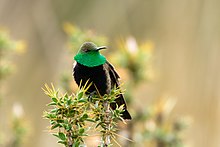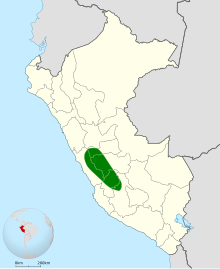Black-breasted hillstar
| Black-breasted hillstar | |
|---|---|

| |
| O. melanogaster observed in Peru | |
| Scientific classification | |
| Domain: | Eukaryota |
| Kingdom: | Animalia |
| Phylum: | Chordata |
| Class: | Aves |
| Clade: | Strisores |
| Order: | Apodiformes |
| Family: | Trochilidae |
| Genus: | Oreotrochilus |
| Species: | O. melanogaster
|
| Binomial name | |
| Oreotrochilus melanogaster Gould, 1847
| |

| |
| Distribution in Peru (green) | |
The black-breasted hillstar (Oreotrochilus melanogaster) is a species of hummingbird in the "coquettes", tribe Lesbiini of subfamily Lesbiinae. It is endemic to Peru.[3][4]
Taxonomy and systematics
The black-breasted hillstar is monotypic.[3]

Description
The black-breasted hillstar is 13 to 14 cm (5.1 to 5.5 in) long and weighs about 8.4 g (0.30 oz). Adults have a medium length slightly decurved black bill. The male's upperparts are bronzy brown. It has a shining emerald green gorget, grayish brown flanks, and entirely black breast, belly, and vent area. The tail is slightly forked and blue-black. The female is dull bronzy brown above and below. Its throat is pale with fine dark speckles. The tail is greenish black and the outer three or four pairs of feathers are white at their tips.[5]
Distribution and habitat
The black-breasted hillstar is found in the central Andes of Peru, primarily in the departments of Junín and Huancavelica. Its range also extends slightly into the adjacent departments of Ancash, Lima, Pasco, and Ayacucho. It inhabits puna grasslands, especially areas with much Chuquiraga spinosa and cushion cacti, and some rock outcroppings as well. It also commonly occurs in gardens and has been noted in Puya raimondii stands. In elevation it ranges between 3,500 and 4,400 metres (11,500 and 14,400 ft).[5]
Behavior
Movement
The black-breasted hillstar is a year-round resident in Junín but in Huancavelica it might leave the puna after cacti stop flowering.[5]
Feeding
The black-breasted hillstar feeds on nectar primarily from Chuquiraga spinosa in Junín; in Huancavelica it favors cactus flowers. It feeds at other flowering plants as well, especially red ones, by trap-lining, and will feed at Eucalyptus. It hawks for insects on the wing.[5]
Breeding
The black-breasted hillstar nests in February and March. It glues a large cup nest to a vertical substrate such as a sheltered rock face and even under the eaves of buildings. The clutch size is two white eggs. Little else is known about the species' breeding phenology.[5]
Vocalization
The black-breasted hillstar's vocalizations are not well known, but it makes a "fast squeaky twittering with rising and falling sequences" when chasing.[5]
Status
The IUCN has assessed the black-breasted hillstar as being of Least Concern. Though its population size is unknown, it is believed to be stable.[1] The species is fairly common to abundant, and its "puna slope habitat is not under particular threat in this region."[5]
References
- ^ a b BirdLife International (2016). "Black-breasted Hillstar Oreotrochilus melanogaster". IUCN Red List of Threatened Species. 2016: e.T22687771A93168534. doi:10.2305/IUCN.UK.2016-3.RLTS.T22687771A93168534.en. Retrieved 21 February 2022.
- ^ "Appendices | CITES". cites.org. Retrieved 14 January 2022.
- ^ a b Gill, F.; Donsker, D.; Rasmussen, P. (January 2022). "IOC World Bird List (v 12.1) – Hummingbirds". Retrieved 15 January 2022.
- ^ HBW and BirdLife International (2020) Handbook of the Birds of the World and BirdLife International digital checklist of the birds of the world Version 5. Available at: http://datazone.birdlife.org/userfiles/file/Species/Taxonomy/HBW-BirdLife_Checklist_v5_Dec20.zip [.xls zipped 1 MB] retrieved 27 May 2021
- ^ a b c d e f g Fjeldså, J. and P. F. D. Boesman (2020). Black-breasted Hillstar (Oreotrochilus melanogaster), version 1.0. In Birds of the World (J. del Hoyo, A. Elliott, J. Sargatal, D. A. Christie, and E. de Juana, Editors). Cornell Lab of Ornithology, Ithaca, NY, USA. https://doi.org/10.2173/bow.blbhil1.01 retrieved 21 February 2022
- Articles with short description
- Short description is different from Wikidata
- Use dmy dates from October 2023
- Use American English from February 2022
- All Wikipedia articles written in American English
- IUCN Red List least concern species
- Articles with 'species' microformats
- Hillstars
- Birds of the Peruvian Andes
- Birds of the Puna grassland
- Endemic birds of Peru
- Birds described in 1847
- Taxonomy articles created by Polbot

